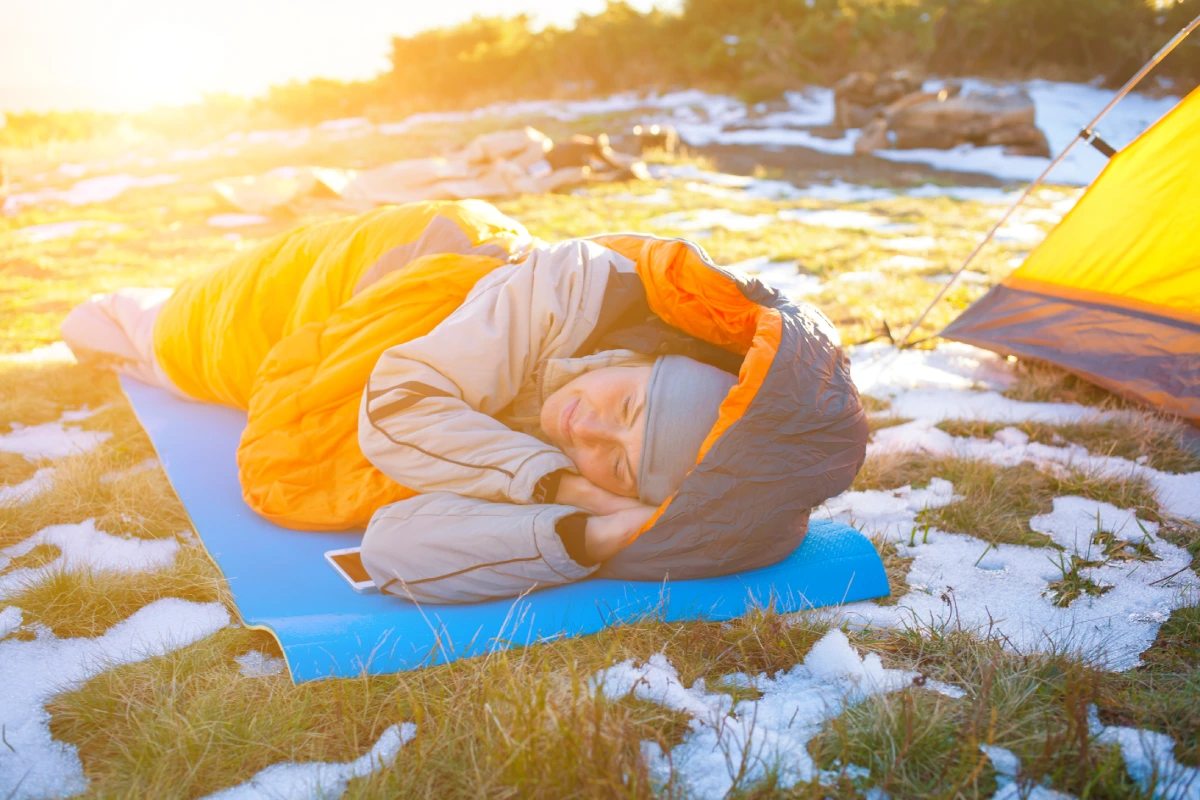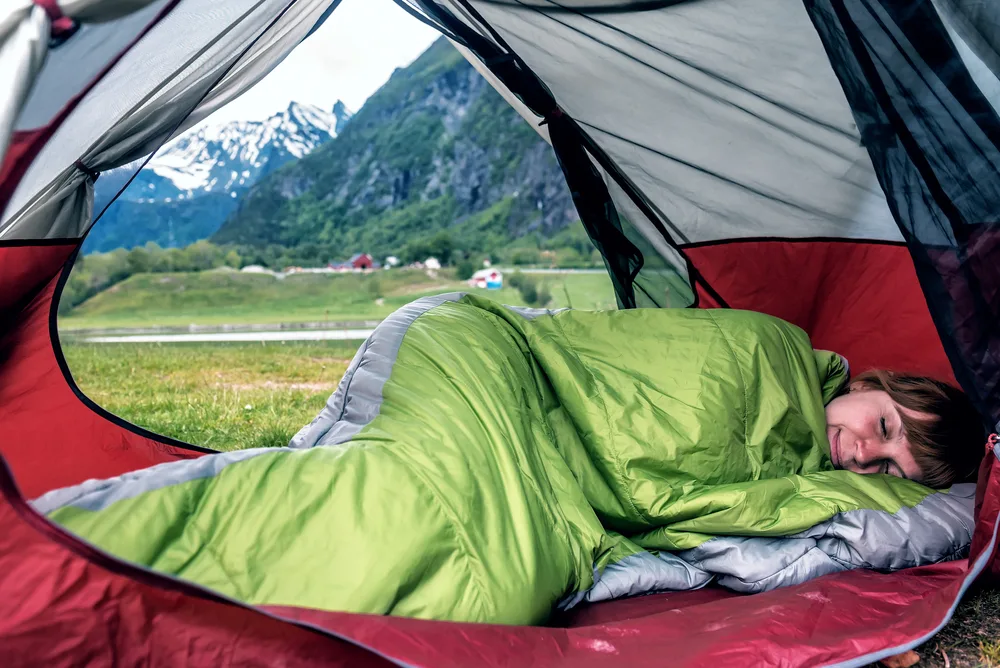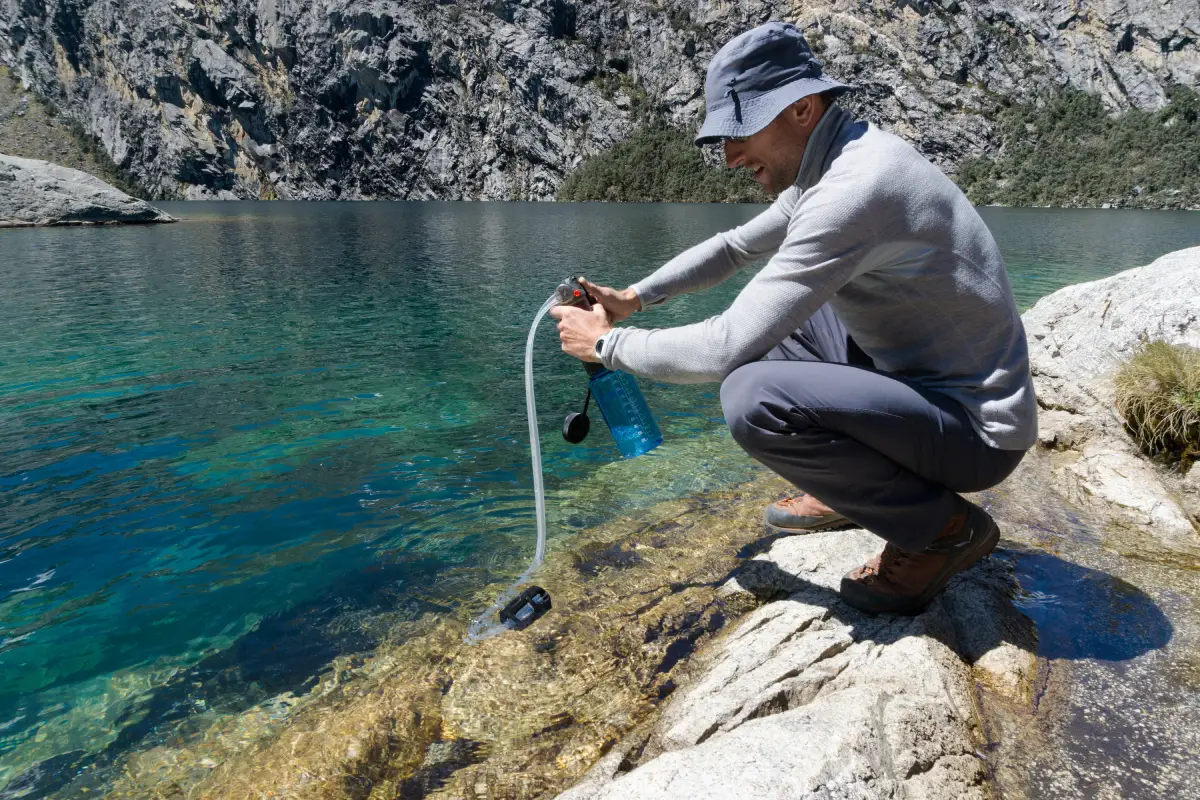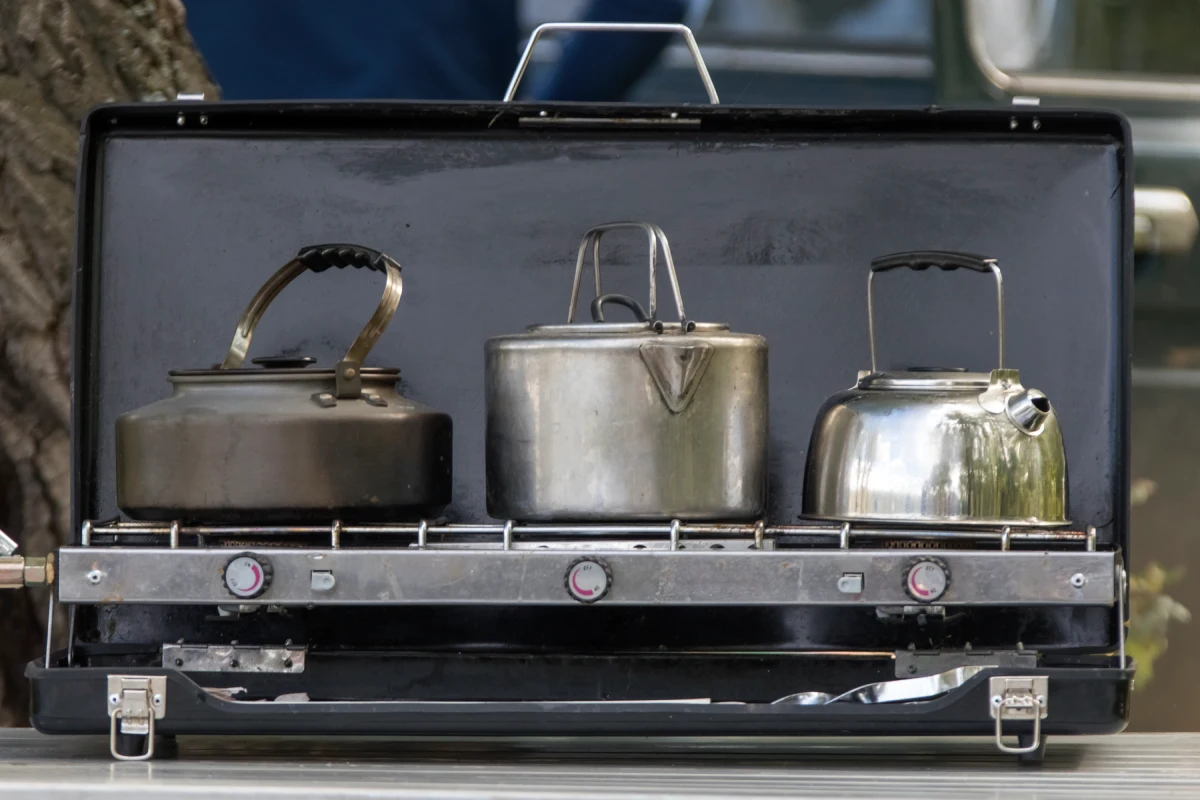In general, the important factors to consider with sleeping bags are size, fit, fill, and temperature ratings. But what about searching for a sleeping bag for women? Isn’t it just a regular sleeping bag found in the outdoor retailer? A warm women’s sleeping bag is essential for a comfortable night’s sleep in cold temperatures. Yet many people find choosing the right one to be a daunting task. Picking one is a common stumbling block for beginners in hiking and backpacking.
A quality sleeping bag is an essential part of an outdoor sleeping system when camping, hiking or backpacking. Since it affects the weight of your pack and the ability to gain a restful sleep. Indoors, we are all guilty of taking sleep for granted. But lacking sleep outdoors will greatly affect your energy levels and efficiency the next day. Experiencing this while car camping isn’t as much of a big deal as backcountry hiking.
In this article, I explain 5 main points. First, what are the real differences between a women’s sleeping bag? Second, the reasons why women are colder than men. Third, some female-specific features and fourth the temperature ratings of sleeping bags. Then to finish up, the buying factors to select a warm sleeping bag that will meet your needs.
I also include a navigable table of contents if you want to read a specific section. Let’s start learning how to choose a warm sleeping bag for women.
What Is A Sleeping Bag For Women?
First, let’s discuss that a woman’s sleeping bag isn’t. It isn’t a pink or purple version of a men’s bag. Thankfully, brands are waking up and starting to grasp that women have different body warmth needs. So, they are putting more effort into redefining how sleeping bags perform for women.
A women’s sleeping bag is a special design that has more insulation, with a woman’s specific length and shape.
At first look it’s shorter than a male-specific bag, men’s bags are about 6 feet (182.88 cm) long. Next, the shape is slimmer in the shoulders and wider in the hips. As well, inside it has more insulation at the feet and in the stomach area than a men’s (unisex) bag will. Let’s move on to the differences between men’s and women’s body chemistry.
Why Do Women Feel Colder Than Men?
Everyone’s bodies are different and many factors affect our internal body temperatures. These factors include our diet, age, fitness, and our amount of sleep. One reason female outdoor enthusiasts feel colder than men is due to an internal factor. This is a person’s metabolic rate.
The body’s metabolism handles energy production, including heat. Since men often have more muscle mass, they create more heat. Males do this by burning (heat) more calories to fuel their extra muscles. As this heat evaporates, it warms up a male’s skin, their clothes and the air right above the surface of their skin. Women tend to have a lower metabolic rate, thus they produce less heat than men do and feel colder.
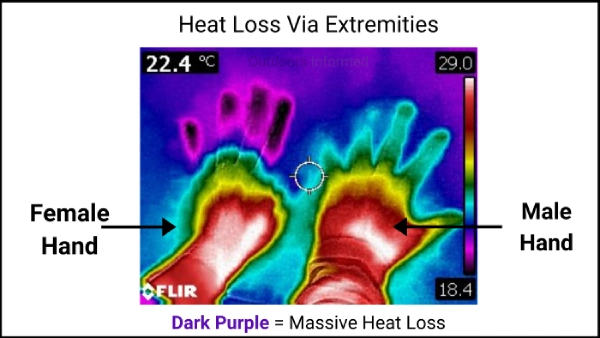
Another difference is women have higher percent body fat with balanced distribution. As a result, a woman’s skin will feel and look softer. Women likewise have more subcutaneous fat. This extra layer gives women a slightly warmer core than men. However, this is problematic for women because the body prioritizes core temperature. This means the body will pull warm blood out from extremities, such as your hands and feet. In-kind, women have chilly extremities more often, which results in feeling colder.
These differences are major factors for interrupting a good night’s sleep outside. Campers who don’t have a warm sleeping bag mixed with a proper sleep setup should expect diminished energy levels.
With women’s physiology in mind, manufacturers are wising up to this under-served market. Female-designed products are starting to catch up with the unisex market. These days, bags for women have feather-light materials, high-quality down, and creative shapes. All combined these features help to give you a better night’s sleep.
Warm Women’s Specific Sleeping Bag Features:
With female-specific sleeping bags, your use determines which features you will focus on. Backpacking or mountaineering users will look for lightweight bags with high compressibility. Campers will look for dense insulation and overall comfort. People looking for a good all-round sleeping bag should pay attention to these four main features.
Four Features Of A Sleeping Bag For Women:
- Length
- Shape
- More insulation per square inch/Distribution Of Insulation
- Weight
Length
The first feature that is special for women is the shorter length of the bag. The reason for a shorter length is that unisex sleeping bag lengths average around 6′. This is much longer than the average height of women in the United States, which is 5’4.” As a result, a typical sleeping bag for men is too long. Moreover, a unisex bag feels roomy due to the extra material. As I mentioned before, most heat loss for women comes from their extremities. Therefore, having a roomy sleeping bag could mean a sleepless night after a long day of trekking.
Shape
With heat loss in mind, the second feature specific to women is changing the shape to fit a female form better. The sleeping bag is a bit wider in the hips, on average about 1.75 inches (44.45 mm). As well as narrower in the shoulders, close to 3 to 5.5 inches (13.97 cm) less. By using a more precise fit, a woman’s body will have more contact with the insulation. This snug fit prevents airflow which pulls heat out from a woman’s body.
More Insulation Per Square Inch/Distribution Of Insulation
Third, the redesigned shape meant companies needed to add more insulation. Doing this is vital to help female backpackers keep in as much heat as possible. Even though women’s bags have more insulation, this doesn’t mean the bag is thicker.
Instead, backpacking companies provide more insulation per square inch than men’s sleeping bags. High amounts of insulation per square inch equate to a warmer sleeping bag. This also controls the volume/size of the sleeping bag. What doesn’t help is the weight, for this reason, women’s bags will weigh the same as men’s.
Manufacturers also began to wise up about where women feel colder, for example, their hands and feet. With this in mind, they are strategic about the placement of this extra insulation. For female-specific sleeping bags, you will find more insulation in the bottom of the bag. To allow for more versatility some companies create continuous baffles in their designs. These allow you to shift the insulation to specific heat-loss areas.
Weight
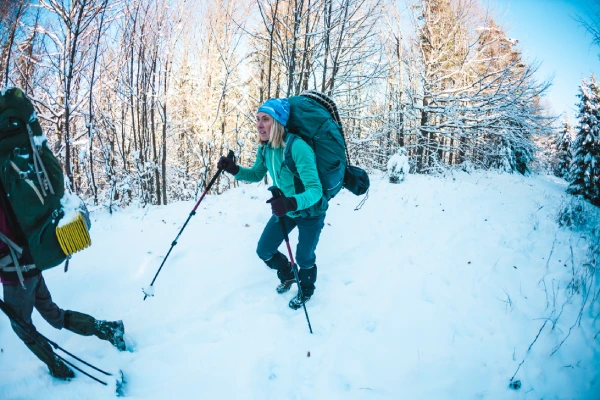
Decades ago, like other outdoor gear, there used to be no such thing as a women’s bag. Women had to make do with what the men used. Over time some companies made the mistake of giving us a “shrink it and pink it” sleeping bag for camping.
Imagine it, a pink, heavy, cumbersome, sleeping bag. Who would think that we women might want to pack and hike a few hundred miles like the men? Well, we do but to keep warm we have to make compromises. The compromise is weight, as ladies’ bags are not lightweight. Depending on how much warmth you want, expect a good 3-season sleeping bag to weigh in the 2 to 3 lb (1.36 kilogram) range.
Which Sleeping Bag Temperature Rating Is Best For Women?
As I talked about above, it is crucial to consider warmth when buying a women’s sleeping bag. Before 2005, there was no proper standard set, and ratings were subjective. Next in 2005, official European testing began. The result was the EN Standard, which ensured that people could make exact comparisons between sleeping bags.
From 2005 to 2017 most reputable sleeping bag companies used independent testing via this standard. This test provided a comfort and temperature limit rating. Next introduced in 2017, was the new ISO Standard. This updated version of the EN ratings is the current testing protocol for all sleeping bags.
To read the EN/ISO sleeping bag rating you will see a range of temperatures, see the image below. These reflect the estimated warmth for a wide spectrum of body types. The actual numbers included along the continuum are points of reference between ranges. In layman’s terms, these ratings are a guide for the lowest temperature that you can expect to sleep well. It’s the main rating to determine if a sleeping bag is appropriate for what you intend to use it for.
The most important temperature rating for women:
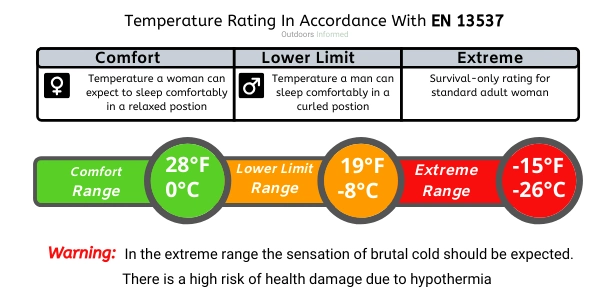
For women, the most important rating to pay attention to is the comfort limit/range. This is the comfortable temperature range to match an expected woman’s body heat. For men, they will pay attention to the lower temperature limit.
When buying based on temperature ratings, think about how hot or cold the areas are on the trips you intend to take. What if you aren’t planning on going high-altitude hiking or backpacking? If not, follow the list below to coordinate temperature ratings to particular seasons.
- Summer Bags: 35 degrees and up
- 3-Season Bags: 15 – 30 degrees
- Winter Bags: 10 degrees and under
If you do venture up high in the mountains, seasonality doesn’t matter. In this instance, you need to shop by anticipated temperature ratings among other factors.
Picking The Best Women’s Sleeping Bag For You
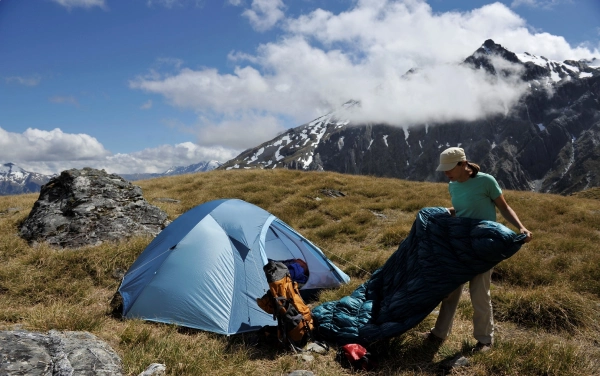
There are tons of sleeping bags on offer in the camping and hiking market. Each gets made with different purposes in mind as well as sold at different price points. Before you start to look into a specific sleeping bag for women, think about your activity.
Consider Your Intended Activity
Are you attempting to conquer the Appalachian Trail? Or are you planning an overnight trip at a low-altitude base camp? If you are spending a lot of time hiking in the alpine, factor in the weight of the bag. For this type of activity, you will want a sleeping bag rated to zero degrees Fahrenheit and below. Realize that the lighter a bag is, the more money it will cost. If not and you are doing single overnight hikes in warm climates, weight won’t matter. For short trips, it is in your best interest to look for a budget-friendly comfortable bag.
Size Matters
As I mentioned before, the biggest difference between a men’s and women’s bag is length. For women who fit the National average (5’4) and under, a women’s regular-length bag is best. If you are 5’6 tall and above, look for a ladies’ bag with a “long” length label. Don’t skimp, as a shorter sleeping bag will cause numbness in your feet. As well as allow for a great amount of heat loss from compressing the insulation around the bag.
Sleeping Bag Shape Makes A Difference
The most popular sleeping bag for women is the mummy-style. This specific shape means the sleeping bag tapers around your feet. It’s popular because it creates less airspace for your feet to have to heat. As well, it helps decreases total bag weight. Some people may feel too contained, although warmth overnight is paramount for sleep.
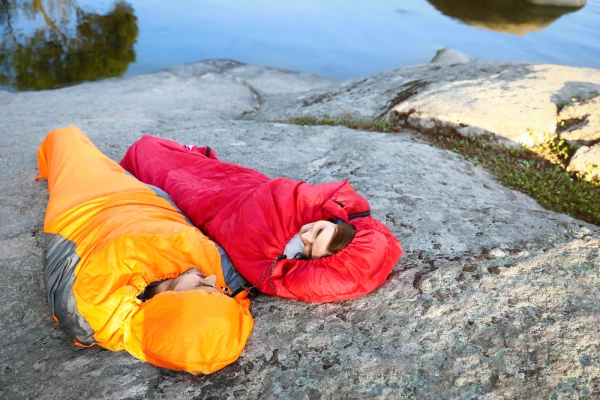
Ideal Features Of A Women’s Sleeping Bag Shape:
Below is a list of the features I look for in any high-quality bag.
Superior Shell: This is the fabric that contains and protects the bag and insulation. Better ones will block wind, and repel moisture.
Secure Hood: Key for keeping you warm in cold temps. The hood should fit comfortably around your head. Look for reachable pull tabs and Velcro that can close on itself, so it doesn’t scratch your skin.
Yoke: U-shaped tube of insulated liner which rests against your neck. As you shift during the night, it helps to block cold air drafts from seeping in.
Draft collar: A tube or flap of insulation at the neck opening. Meant to trap heat and prevent drafts. Critical for sleeping bags rated at 20 °F or lower.
Tapered Foot Box: As mentioned before it’s better to have little wiggle room. Look for bags with foot box sidewalls, so your feet won’t press into the insulation which can cause cold spots.
Smooth-Moving Zipper: Poor zippers are the bane of many backpackers. Good quality bags will have stiff backing fabric to prevent zipper snags. Some have a centered zipper, which is great to shave off weight. I also like that it allows you to sit up and perform camp chores while warm.
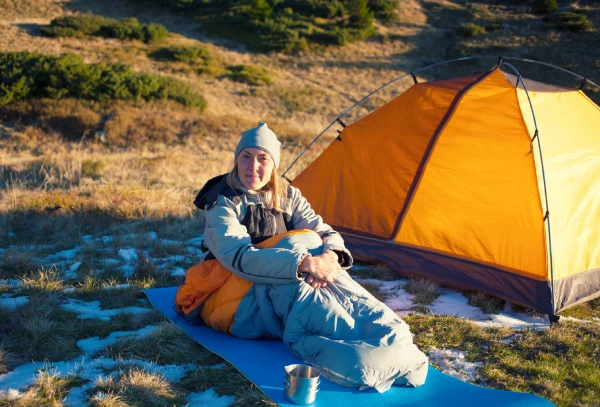
Insulated Draft Tube: This is a tube of insulated fabric that lies behind the zipper. Its purpose is to block air from seeping through the zipper coils.
Baffles: These are interior chambers inside the bag. They keep insulation from shifting around or bunching up.
Stash Pockets: Zippered pockets for easy storage of your important items.
Pad Straps: These are fabric straps found on the edge of the bag. These help to prevent the bag from sliding off a sleeping pad.
Sleeping Bag Insulation: Down or Synthetic Fill Material
This is the age-old question. To answer it you need to determine your activity and budget. You only have two types of insulation to choose from in a sleeping bag. Either down/goose fill or synthetic fill.
- Down or goose insulation = Best for backpacking
The pros of this insulation are its a bit lighter, warmer, and more compressible. For con’s it loses its loft over time, and with it a significant amount of its warmth, particularly when wet. Plus it is more expensive.
- Synthetic insulation = Best for camping
The opposite of downfill, it will maintain its loft when wet and continue to keep you warm. But it weighs more, is less durable, and bulkier. Yet it costs less than down insulation. This is an option for female hikers who are against using animal products. Or for women with allergies.
What Is Hydrophobic Down Filling?
Since most backpackers trek in wet environments, could there be a solution for wet downfill? There is, manufacturers developed a “hydrophobic down” coating to compete with synthetic bags. This is a proprietary waterproofing treatment of the fill. Is it a perfect solution? It’s still a newer technology but all the same downfill bags are easier to pack and warmer. If you can afford this insulation type, it’s a worthwhile investment.
How Can I Increase The Warmth Of My Sleeping Bag?
The best way to increase the warmth in your sleeping bag is to separate yourself from the cold earth. Remember how cold we women feel compared to men, do you think the earth wants to steal your body heat? Of course, it does, so you need to get off the ground with a “sleeping pad.” A sleeping bag and sleeping pad go hand in hand for a warm night outside.
This is the best advice I can give you for looking for a sleeping pad: pay attention to “ R-value” and activity.
Like the EN/ISO ratings, an R-value is a measurement of a material’s thermal resistance to heat loss. This numerical rating helps you to pick the right sleeping pad for a given activity. To clarify, the higher the R-value, the better.
- Using it to trek outside during summer, sleeping pads with R-values of 0-2 are decent.
- Trekking from spring through fall look for R-values of 2-4.
- Backpacking just below-freezing areas, pick R-values of 4-6.
- Winter camping or hiking and having to sleep against snow? It’s best to choose a pad with a 5+ R-value.
Below is a basic table to help you decide which type of sleeping pad is right for your needs, dependent on activity.
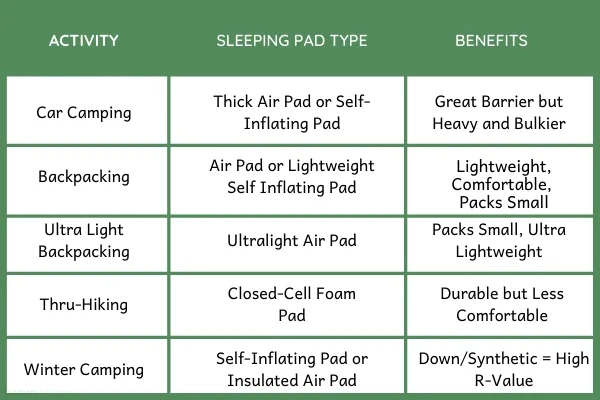
Taking Care Of Your New Warm Sleeping Bag
Okay, you buy your new sleeping bag, and you want it to last right? In this section, I explain four ways to extend the life expectancy of your new investment.
Proper Storage
Good quality sleeping bags for female hikers come with two kinds of storage sacks.
One should be large and made of mesh or some type of light breathable material. For both synthetic a down insulated sleeping bags both trap air inside to keep you warm. For this reason, it’s vital to store your bag “uncompressed.” This is because the insulation won’t get crushed losing its ability to loft out again when you want to use it. This is the purpose of the large mesh bag, for long-term storage.
The other bag is a much smaller bag made of durable material, it’s your stuff sack. Is a compression sack the same? No, is an optional bag for ultralight hikers. It has external straps to shrink and pack a bag down to the smallest possible size. If you buy one be sure to not store a sleeping bag with this for an extended time or expect damaged insulation.
It’s best to store sleeping bags out of direct sunlight. Either hanging from the loops or under a piece of furniture.
Correct Usage
When using your sleeping bag in the wilderness do your best to keep it clean and protected from abrasion. Be mindful of muddy hiking boots and never walk across the bag unless barefoot. Another way to protect from damage is to keep your bag off the bare ground, either in a tent or on a sleeping pad.
Getting a sleeping bag wet is inevitable, either from rain, dew, frost, or sweat. You must make sure to dry it out when possible. Dry your bag out of direct sunlight because UV rays can damage outer bag materials. Although, if hiking in snow this may not be possible. Whatever you do, try not to compress the sleeping bag when wet. This is critical for downfill insulation, if you do compress it, it won’t loft out again until it dries out.
Wash After Use
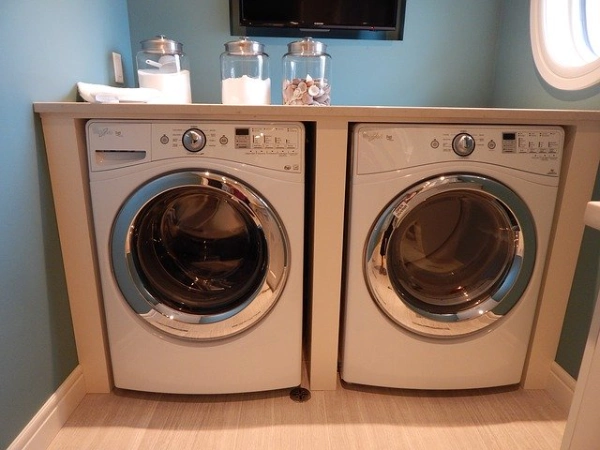
Everyone’s sleeping bag gets dirty, despite our best efforts. Great treks outside result in stinky, dirty hikers crawling inside the bag and that bag will need a wash. The method you wash your sleeping bag depends on the kind of insulation.
Down Fill
Inside this fill type has plumes coated with natural oils for protection and to aid in lofting out to trap air. When these plumes get dirty they can’t loft out as much, meaning the bag won’t be as warm as intended. Use a front-loading washing machine with laundry soap made for washing technical down. Do not use regular laundry detergent as the down will strip out the natural oils. It may look clean, but it sure won’t be as warm as it used to be.
Can you put a sleeping bag in the dryer? Yes, feel free to throw the bag in the dryer at a low setting. Add a couple of clean tennis balls in the dryer to bust up clumpy down pockets. While noisy, the results will amaze you.
Synthetic Fill
Use the same process as down except use a detergent specific to synthetic material. Dry a synthetic sleeping bag on a low setting with tennis balls for a lofty finish. Washing a sleeping bag well will ensure a clean bag inside and out. While also helping it last longer and protecting your investment.
Sleeping Bag Repairs
Out in the wild outdoors and get a tear in your bag? You have a few options for DIY repair. First, bring a sleeping bag-specific repair tape with you when you hike. A good technical repair tape is flexible and sticks to nylon outer materials.
If you run out of this tape or forget to bring it your second option is Duct tape. Although this is a short-term fix at best because it tends to rip off when pulled in and out of stuff sacks.
The third option is to send it back to the manufacturer for repair. This is the best long-term but also the most expensive. Many brands have repair shops, and for a fee, they will fix your hiking gear.
Finishing Up: Sleeping Bag For Women
Now you have the info to pick a warm sleeping bag for women. It’s an unfortunate fact that we have less selection for female-specific sleeping bags. For ultralight hikers or tall ladies (5’6+), you might need to pick a unisex sleeping bag or quilt. If you are, ensure to pick one that isn’t too big and rated 15 degrees warmer to compensate for the extra airflow. Otherwise, for average-height ladies, follow this:
Hiking/Camping Activity + Material Preference/Fit + Cost = A Warm Sleeping Bag
